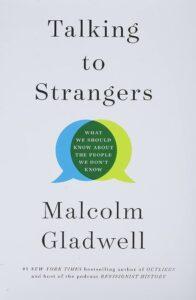 Summary
Summary
“Talking to Strangers” is Malcolm Gladwell’s exploration into the intricacies and potential dangers of our interactions with people we don’t know. Through a series of case studies, historical events, and psychological insights, Gladwell unravels the complexities of understanding strangers.
Default to Truth
Gladwell introduces the concept of “default to truth,” suggesting that humans inherently believe others unless there’s substantial evidence to the contrary. This inclination is evolutionary, allowing societies to function cohesively. However, it also makes us susceptible to deceit. He cites the case of Jerry Sandusky, the Penn State assistant football coach. Despite multiple allegations and signs of misconduct, many around Sandusky defaulted to believing his innocence, leading to prolonged abuse.
Transparency Issue:
The book delves into the idea of “transparency” – our expectation that people’s external behavior and expressions will transparently reflect their internal emotions and intentions. This is, however, a flawed assumption. Gladwell uses the case of Amanda Knox, an American student accused of murder in Italy. Knox’s reactions and demeanor after her roommate’s death didn’t fit the expected mold of a grieving friend, leading many to misjudge her as guilty.
Mismatched Behaviors:
Gladwell introduces the concept of “mismatched” individuals – those whose behaviors don’t align with societal expectations. For instance, someone telling the truth might appear nervous, while a liar might come across as confident. This mismatch can lead to grave misunderstandings, especially in high-stakes situations like criminal interrogations.
The Illusion of Asymmetric Insight:
We often believe we understand strangers better than they understand us, leading to an overconfidence in our judgments. This illusion can be particularly problematic in situations like espionage. Gladwell recounts the story of Ana Montes, an American who spied for Cuba. Her colleagues failed to see through her deceptions, believing they understood her motivations and loyalties.
The Role of Alcohol:
Gladwell’s exploration of alcohol’s effects on decision-making is particularly intriguing. He suggests that alcohol creates a “myopia” effect, making individuals focus on immediate feelings and environments, often sidelining broader implications or consequences. This short-sightedness can lead to poor judgments, especially in unfamiliar or risky situations involving strangers.
Policing and Distrust
Using the tragic case of Sandra Bland, an African American woman arrested during a routine traffic stop and later found dead in her jail cell, Gladwell delves into the strategies and mindsets of law enforcement. He critiques the “broken windows” policing approach, which emphasizes strict enforcement of minor violations as a deterrent for more severe crimes. While this approach might have its merits, it can also escalate minor interactions into major confrontations, increasing tension and misunderstandings between police and the public.
Torture as a Tool
Gladwell critically examines the use of torture, especially in the context of the CIA’s post-9/11 tactics. He argues that beyond the moral implications, torture is an ineffective tool for extracting accurate information. Under extreme stress and pain, individuals are likely to say anything to end their suffering, leading to unreliable or false information.
Digital Age and Strangers:
In our modern era, interactions with strangers aren’t limited to face-to-face encounters. Digital platforms, from social media to online dating, have expanded our stranger interactions exponentially. Gladwell discusses the potential dangers of these digital interactions, emphasizing how online environments can magnify misunderstandings. The lack of physical cues and the ease of deception online can lead to misjudgments with real-world consequences.
Espionage and Trust:
Drawing from the world of espionage, Gladwell highlights the challenges faced by intelligence agencies in deciphering loyalties and intentions. The story of Oleg Gordievsky, a double agent during the Cold War, serves as a prime example. Intelligence agencies must navigate a world filled with deception, where the cost of misplaced trust can be national security.
Reevaluating Our Approach:
Gladwell concludes by urging readers to approach interactions with strangers with a renewed sense of caution and humility. Recognizing the inherent challenges in understanding unfamiliar individuals can lead to more compassionate, accurate, and nuanced interactions.
In “Talking to Strangers,” Gladwell masterfully weaves together historical events, psychological insights, and compelling narratives to highlight the complexities of human interactions. He challenges readers to reconsider their assumptions, biases, and strategies when dealing with people outside their familiar circles. In doing so, he offers a roadmap for navigating a world where our interactions with strangers are both inevitable and potentially fraught with misunderstandings.
Discussion Questions
- How do you think the “default to truth” theory impacts our daily interactions with strangers?
- Can you recall a personal experience where the “transparency” assumption led to a misunderstanding with someone unfamiliar?
- How might society change if we didn’t inherently default to believing others?
- In what situations do you think the “mismatched” behaviors are most evident, and why?
- How does the illusion of asymmetric insight play out in modern digital communications, such as social media or online dating?
- Considering Gladwell’s discussion on alcohol-induced myopia, how can individuals ensure safer interactions with strangers in social settings?
- What are the potential dangers of the “broken windows” policing approach, especially in diverse communities?
- How do you feel about the use of torture as an interrogation tool, especially given its potential ineffectiveness as highlighted by Gladwell?
- In the digital age, how can we better navigate interactions with strangers online to avoid misunderstandings or potential dangers?
- How do the challenges faced by intelligence agencies in deciphering loyalties relate to our everyday judgments of strangers?
- What strategies can individuals employ to approach interactions with strangers with more caution and humility?
- How do societal norms and expectations influence our perceptions of “mismatched” behaviors?
- How can law enforcement agencies strike a balance between maintaining order and avoiding unnecessary confrontations with the public?
- In what ways do you think the rise of virtual communications has amplified the challenges of understanding strangers?
- How can we cultivate a more discerning approach to interactions without becoming overly skeptical or distrustful?
- How do cultural differences play into the challenges of understanding strangers, especially in a globalized world?
- How might the concepts discussed by Gladwell apply to professional settings, such as job interviews or business negotiations?
- Considering the case of Sandra Bland, how can individuals and communities advocate for more compassionate and understanding policing?
- How do you think the concepts in “Talking to Strangers” relate to the broader themes of bias, prejudice, and stereotyping?
- After understanding the complexities highlighted by Gladwell, how can we educate younger generations to navigate interactions with strangers more effectively?
Vocabulary
- Intricacies Details, especially of an involved or perplexing subject. The intricacies of the legal system often require expert guidance to navigate.
- Default A preselected option adopted when no alternative is specified. If you don’t choose a color, the software will default to black.
- Cohesively In a manner that is well-integrated or unified. The team worked cohesively to finish the project on time.
- Transparency The quality of being easy to see through or understand. The company’s transparency in its financial dealings earned it a lot of trust.
- Mismatched Not matching or being unsuitable in combination. His mismatched socks drew some amused glances.
- Asymmetric Insight The belief that one understands others better than others understand them. Her assumption of asymmetric insight led her to believe she had the upper hand in the negotiation.
- Myopia Lack of foresight or discernment; a narrow view of something. His myopia regarding the market trends cost the company dearly.
- Deterrent Something that discourages or is intended to discourage someone from doing something. High fines serve as a deterrent to potential lawbreakers.
- Escalate To increase in intensity or severity. It’s important to address conflicts before they escalate.
- Torture The act of inflicting severe pain as a means of punishment, revenge, or forcing information. International laws prohibit the use of torture on prisoners of war.
- Digital Age The present time, characterized by the widespread use of digital technology. In the digital age, information is more accessible than ever before.
- Espionage The practice of spying or using spies to obtain information. Espionage has always been a key tool in the world of international politics.
- Deciphering Succeeding in understanding, interpreting, or identifying something. Deciphering the ancient script took the team several years.
- Reevaluating Consider or assess something again, especially with a view to changing one’s assessment or decision. After the trial, the company began reevaluating its safety protocols.
- Fraught Filled with or likely to result in something undesirable. The negotiations were fraught with difficulties from the start.
Views: 146






Leave a Reply